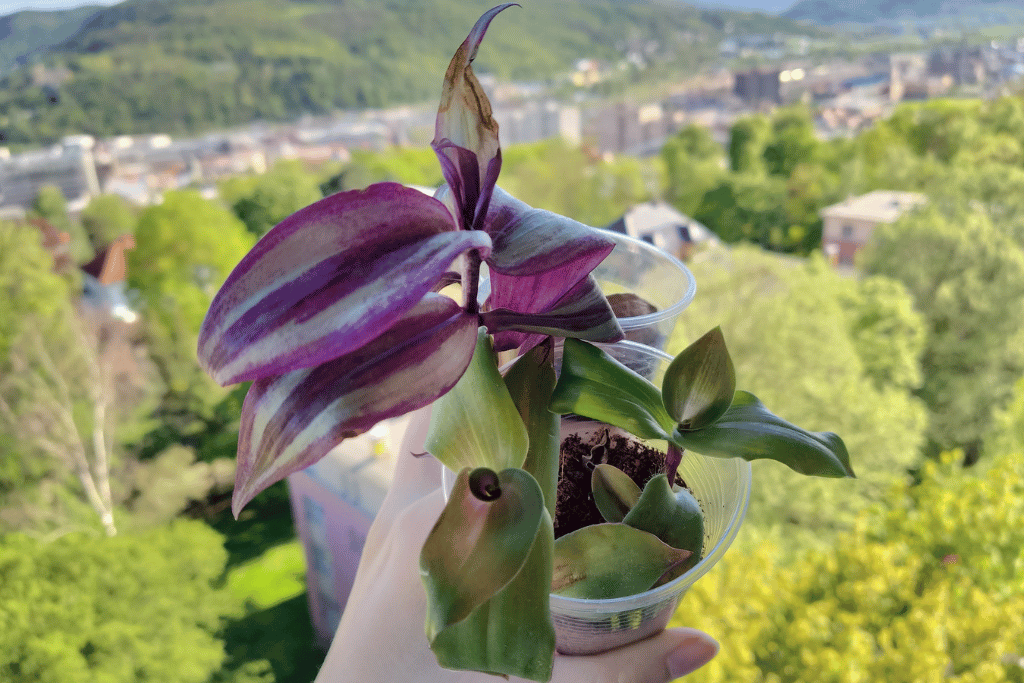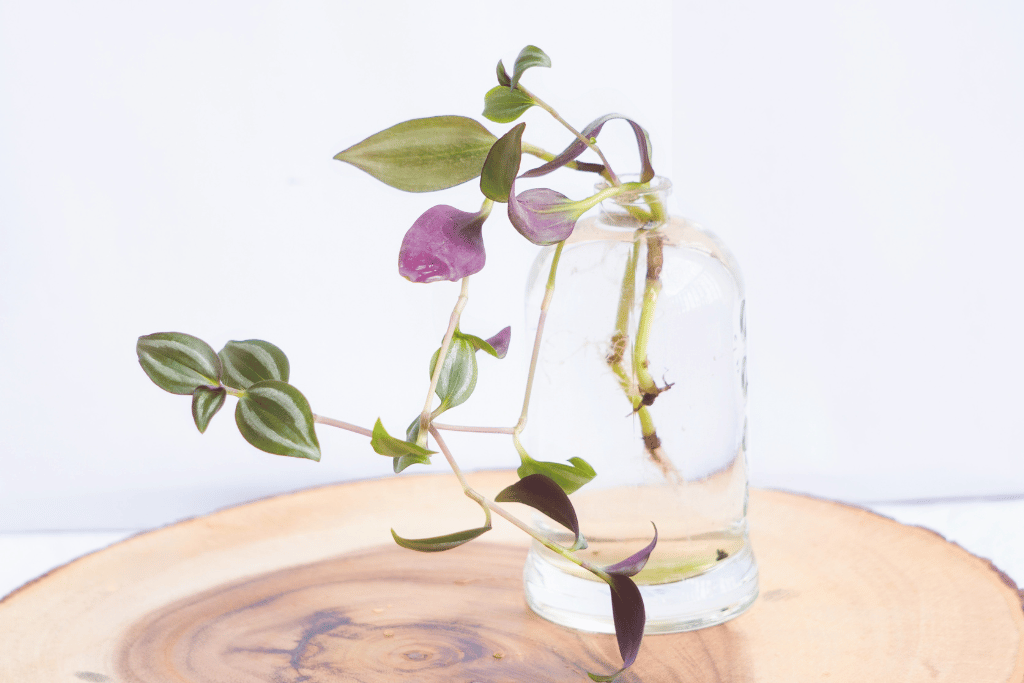
The Wandering Jew plant, or Tradescantia Zebrina, is a widely admired trailing foliage with vivid purple and silver leaves. This resilient plant can be propagated to expand its reach. And as far as the method is concerned, it’s quite easy!
While the plant is super attractive when it comes to aesthetics, let’s not forget its air-purifying abilities that help enhance the quality of air in your environment. It’s an added plus!
So, in this article, I’ll be sharing my experience and knowledge on how to propagate wandering jew plant in easier steps. Moreover, I’ll also discuss successful tips to help you grow your Wandering Jew collection.
So, let’s begin:
Propagation Methods
There are two primary methods of propagating a Wandering Jew plant: soil and water. Let’s delve into both options.
How to propagate wandering jew in soil:

- Get the necessary tools: To initiate the propagation process, assemble all of your essential materials. You’ll need a pair of sharp scissors or pruning shears, a clean container full of fresh potting soil and some water – with these items you’re ready to get started.
- Select the cuttings: To propagate your Wandering Jew plant, it’s best to select healthy stems during the spring or summer when the foliage is flourishing. Be sure each stem you pick has at least one leaf on them for better success.
- Making the cut: Take your scissors or pruning shears and make a precise cut directly below the node (where the leaves meet the stem). Strip any remaining leaves from the bottom of your cutting; leave only two to three leaves at its apex.
- Plant the cuttings: Submerge the cut end of your cutting into a cup of water, then lightly dip it in rooting hormone powder (optional). Place the cutting an inch deep into soil which should cover up its node. Lastly, press down on the surrounding soil to secure it firmly in place and you’re done.
- Water the cutting: Soak your newly planted cutting and allow the excess water to drain away. However, take caution – too much moisture can cause rot, so don’t overdo it with the watering.
- Provide Light and Humidity: Put the container in a spot with indirect light for at least 6 hours, and keep a high level of humidity close by. You can cover it up with a plastic bag or use an enclosed dome to maintain moisture levels around the cutting.
- Wait for Growth: In a matter of weeks, you should start to see new growth on your cutting; this is the sign that it has begun rooting. After this point, you can take away the plastic bag or humidity dome and treat your Wandering Jew as per usual.
How to propagate wandering jew in water:

To get started, pick healthy cuttings with at least one leaf and trim them off the parent plant using scissors that are both clean and sharp. Then, fill a clear glass or jar with fresh water and place your chosen cuttings inside it.
Tip: Positioning your container in an area filled with indirect light is critical since direct sunlight may be too powerful for the young plants’ wellbeing.
To guarantee that your cuttings take root, you should replace the water every two to three days. This will stop bacteria growth and keep the liquid clean. After some weeks, be sure to stay on the lookout for roots starting at around an inch long from each node of the cutting — this is a sign that it’s time to place them in soil.
Now, carefully extract the cuttings from their water environment and plant them in freshly moistened potting soil. Make sure to bury both roots as well as the lower section of each stem for maximum nourishment. Place your newly potted Wandering Jew in a bright spot with indirect light, making sure that you keep it adequately hydrated; neither too dry nor oversaturated.
Tips for Successful Wandering Jew Propagation
To ensure your plants thrive, here are a few proven techniques you can use.
1. Using rooting hormone
For successful and speedy propagation, rooting hormone is an essential tool. When utilizing this product with your wandering Jew cuttings, simply dip the freshly-cut end of the stem into the powder before planting it in either soil or water – simple as that.
2. Choosing the right soil or water
To propagate a wandering Jew, you have two main choices: water or soil. If opting for the latter, use a high-quality soil mix that has excellent drainage capabilities and is packed with organic matter. As for water propagation, simply place your cuttings in clean water inside of either a jar or vase. Don’t forget to ensure at least one node – the point where leaves attach themselves to the stem – is submerged beneath the surface.
3. Providing adequate lighting
It’s key to position your cuttings in an area that receives 6-7 hours of bright indirect light. Remember though: too much direct sunlight can scorch their leaves–so be sure to keep them out of harsh rays.
4. Monitoring watering
It is critical to maintain the soil or water they reside in consistently moist. However, be wary not to overwater as this can lead to root rot; likewise avoid allowing the cuttings to dry out completely as this will cause them to wither and die. Make sure you provide your plant with regular watering but take care that there isn’t a build-up of standing water around its roots – otherwise you risk rotting issues once again!.
5. Ensuring proper humidity
Maintaining a high humidity level is critical to ensure the successful propagation of Wandering Jew plants. To keep the air around your cuttings moist, consider strategically placing a tray of water nearby or turning on an indoor humidifier. Alternatively, you could opt for sealing in moisture by draping your cuttings with either plastic bags or domes.
6. Number of cuttings
When it comes to propagation, you can make as many wandering Jew cuttings as your needs and the size of the parent plant allow. But don’t forget that each cutting requires adequate space and resources for optimal growth.
7. Timing
The timing of taking cuttings must also be taken into account. The optimal time to take your cuttings is in spring or summer when the plant is actively thriving. Be sure to avoid trying to propagate during winter months, as this may result in an inactive plant and unsuccessful propagation attempts.

Conclusion
So that’s all there is to know on how to propagate wandering jew cuttings. It is a valuable skill that will help you multiply your wandering jews and keep your garden full of colors! Why not try it today?!
Frequently Asked Questions (FAQ)
How to propagate wandering jew lilac?
The most efficient way to propagate a wandering jew lilac is by taking stem cuttings. Cut the stems approximately 3-4″ long and strip away any lower leaves.
Optional: Dip the end into rooting hormone powder for accelerated growth. Then, place the cutting inside of a pot with moistened soil mix and cover it off with either a plastic bag or dome to maintain humidity levels while they take root!
How to propagate wandering jew plants blue variety?
Propagating wandering jew plants blue variety is similar to propagating the lilac variety.
What is the best time to propagate wandering jew?
It’s best to propagate them during spring or early summer. Doing so ensures that the cuttings get plenty of time to take root and mature before winter arrives. Note that the soil temperature should be above 60°F (15°C) when you are taking stem cuttings.
How often should I water the cuttings?
Regular watering is required! However, do not make it soggy. Make a habit of watering in the morning so that you can dry out the excess moisture by evening.
How long does it take for the cuttings to root?
The normal timeframe is between 1-4 weeks for wandering jew cuttings to take root.



